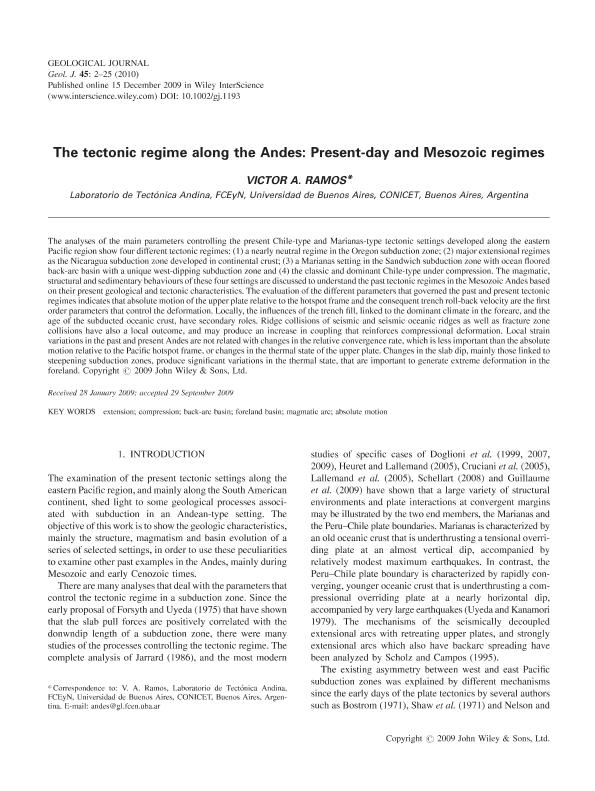Mostrar el registro sencillo del ítem
dc.contributor.author
Ramos, Victor Alberto

dc.date.available
2019-01-23T18:38:47Z
dc.date.issued
2010-01
dc.identifier.citation
Ramos, Victor Alberto; The tectonic regime along the Andes: Present-day and Mesozoic regimes; John Wiley & Sons Ltd; Geological Journal (Chichester); 45; 1; 1-2010; 2-25
dc.identifier.issn
0072-1050
dc.identifier.uri
http://hdl.handle.net/11336/68460
dc.description.abstract
The analyses of the main parameters controlling the present Chile-type and Marianas-type tectonic settings developed along the eastern Pacific region show four different tectonic regimes: (1) a nearly neutral regime in the Oregon subduction zone; (2) major extensional regimes as the Nicaragua subduction zone developed in continental crust; (3) a Marianas setting in the Sandwich subduction zone with ocean floored back-arc basin with a unique west-dipping subduction zone and (4) the classic and dominant Chile-type under compression. The magmatic, structural and sedimentary behaviours of these four settings are discussed to understand the past tectonic regimes in the Mesozoic Andes based on their present geological and tectonic characteristics. The evaluation of the different parameters that governed the past and present tectonic regimes indicates that absolute motion of the upper plate relative to the hotspot frame and the consequent trench roll-back velocity are the first order parameters that control the deformation. Locally, the influences of the trench fill, linked to the dominant climate in the forearc, and the age of the subducted oceanic crust, have secondary roles. Ridge collisions of seismic and seismic oceanic ridges as well as fracture zone collisions have also a local outcome, and may produce an increase in coupling that reinforces compressional deformation. Local strain variations in the past and present Andes are not related with changes in the relative convergence rate, which is less important than the absolute motion relative to the Pacific hotspot frame, or changes in the thermal state of the upper plate. Changes in the slab dip, mainly those linked to steepening subduction zones, produce significant variations in the thermal state, that are important to generate extreme deformation in the foreland.
dc.format
application/pdf
dc.language.iso
eng
dc.publisher
John Wiley & Sons Ltd

dc.rights
info:eu-repo/semantics/openAccess
dc.rights.uri
https://creativecommons.org/licenses/by-nc-sa/2.5/ar/
dc.subject
Absolute Motion
dc.subject
Back-Arc Basin
dc.subject
Compression
dc.subject
Extension
dc.subject
Foreland Basin
dc.subject
Magmatic Arc
dc.subject.classification
Meteorología y Ciencias Atmosféricas

dc.subject.classification
Ciencias de la Tierra y relacionadas con el Medio Ambiente

dc.subject.classification
CIENCIAS NATURALES Y EXACTAS

dc.title
The tectonic regime along the Andes: Present-day and Mesozoic regimes
dc.type
info:eu-repo/semantics/article
dc.type
info:ar-repo/semantics/artículo
dc.type
info:eu-repo/semantics/publishedVersion
dc.date.updated
2019-01-23T17:08:05Z
dc.journal.volume
45
dc.journal.number
1
dc.journal.pagination
2-25
dc.journal.pais
Reino Unido

dc.journal.ciudad
Londres
dc.description.fil
Fil: Ramos, Victor Alberto. Consejo Nacional de Investigaciones Científicas y Técnicas. Oficina de Coordinación Administrativa Ciudad Universitaria. Instituto de Estudios Andinos "Don Pablo Groeber". Universidad de Buenos Aires. Facultad de Ciencias Exactas y Naturales. Instituto de Estudios Andinos "Don Pablo Groeber"; Argentina. Universidad de Buenos Aires. Facultad de Ciencias Exactas y Naturales. Departamento de Geología. Laboratorio de Tectónica Andina; Argentina
dc.journal.title
Geological Journal (Chichester)

dc.relation.alternativeid
info:eu-repo/semantics/altIdentifier/doi/http://dx.doi.org/10.1002/gj.1193
dc.relation.alternativeid
info:eu-repo/semantics/altIdentifier/url/https://onlinelibrary.wiley.com/doi/abs/10.1002/gj.1193
Archivos asociados
